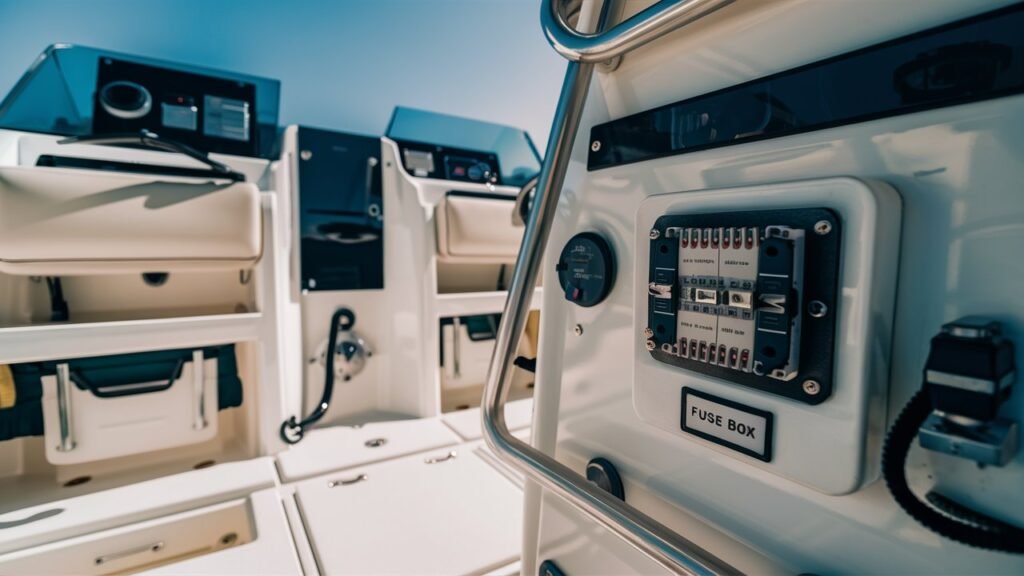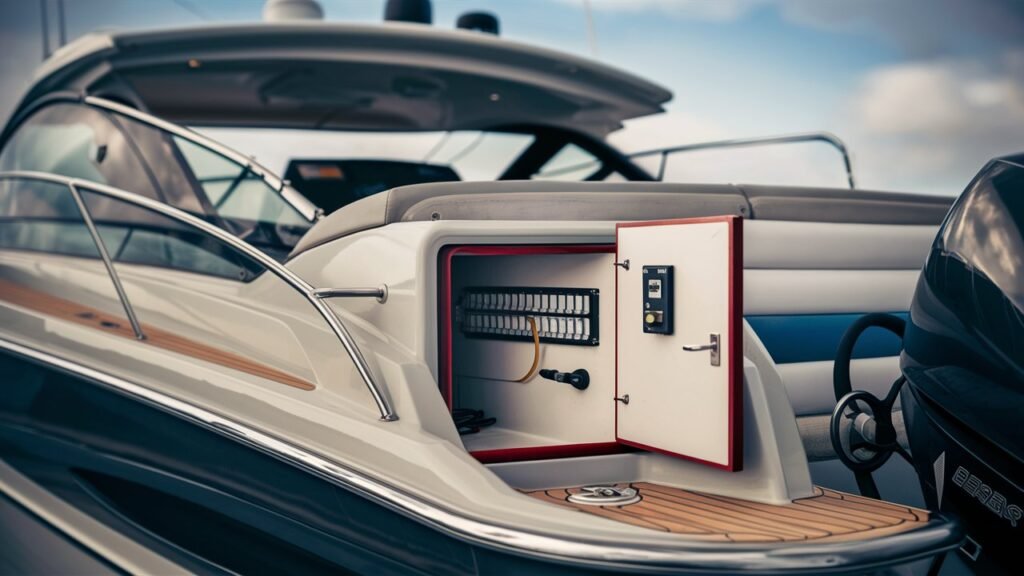Where is the fuse box on a boat?
Where is the fuse box on a boat? The fuse box on a boat is typically located behind the driver’s seat or console, often on the right side.
It is typically fastened on a plastic board and overlaid with a black covering.
When the power or bilge pump does not work, you must check the fuse box.
Bad connection or overload can cause blown fuses or tripped circuit breakers inside the box.
All you have to do to access the fuse box is take off the cover and see if there are any blown fuses or breaker switches.
It’s an easy fix if you have the right manual and some basic working knowledge of boat wires and circuits. Make sure to turn off all power before attempting to change any fuses.
What is the importance of the fuse box on a boat?

It is very important that boats have a fuse box to be safe and function properly.
Usually situated close to the battery terminal or switch panel, the fuse box guards against overloading and potential fire hazards of the watercraft’s electrical system.
If there is a short circuit or power surge, the fuse will blow out the circuit to save engine and other electrical components from damage.
This is extremely vital in a boat where additional dangers are posed by both water and lightning.
The owner can ensure everyone on board is safe and prolongs his/her boat’s electrical system by regularly inspecting and maintaining the fuse box.
Remember, a well-maintained fuse box can help prevent accidents and ensure smooth running of your boat.
Understanding the role of fuses in a boat’s electrical system
Understanding the role of fuses in a boat’s electrical system
To get the right idea about what fuses perform in a boat’s electrical system, it is very important to find a reliable site.
Fuses are an essential part that protect boats’ electrical components from being damaged by currents that exceed their capacities.
Should there be no correct fuse arrangements in place, the chances are high that watercraft’s electrical systems could break down completely.
The process of grasping some knowledge on fuses and how they function should start for any boat user.
There was one comment in 2007 where another boat owner said he had warranty issues solved buy just replacing a blown fuse.
A user thread of 2008 also showed how significant it is to keep checking and replacing fuses to avoid anyone getting trapped on sea without light or driver controls.
How to locate the fuse box on a boat?

Looking for the fuse box on a boat: In case you lack knowledge about where to locate the fuse box in your boat then kindly consult the manual or call the manufacturer for assistance.
Mostly, in boats, you can find its fuse box around its engine room or near its helm space.
Find a board which can be opened and closed easily to get to these fuses.
Now, remove this cover gently and expose those fuses within it.
Only change blown fuses with ones of recommended amperage rating so as not to endanger yourself or cause fire or damage.
If confused about which fuses that suits your boat, consult a marine electrician or reach out to the manufacturer for further assistance.
Make sure that you put off power supply before touching any part of this fuse board because it is usually very dangerous.
Locating the fuse panel on different types of boats

The location of the fuse panel on different types of boats may vary depending on the make and model.
Fuse panels in smaller boats, such as centre console fishing boats are usually positioned near the helm or console for easy access by the captain.
Fuse panels may be located at a dedicated electrical compartment or an engine room in bigger vessels like yachts and cruisers.
Finding the fuse panel is vital to dealing with any electrical problems that might occur when offshore.
It is recommended to familiarise yourself with the location of the fuse panel before setting sail to ensure quick and easy access in case of an emergency.
If you are unsure of where the fuse panel is located on your boat, consult the owner’s manual or contact the manufacturer for guidance.
Accessing the fuse box on a bass boat
One important aspect of a routine check-up and trouble shooting is finding the fuse box in a bass boat.
This component is usually situated near the pilot seat or console, where it houses fuses that serve to protect wiring of the vessel.
In order to gain access to the fuse box, the power source should be switched off in order to ensure no electrical shocks are experienced by those working on.
To begin with, you must seek out the covering on top of the fuse box and remove it using an appropriate tool like a screw driver for example.
This will enable you to look at at least one wire as well as fuses when the cover comes off.
Find out if there are any dead ones among these but remember that some need replacements.
While dealing with electrical system of a bass boat, it’s crucial for one to handle it with care while also observing safety guidelines.
How to replace fuses in the fuse box of a boat?

Replacing boat fuses in a fuse box is a fairly undemanding process if you follow a few instructions.
First, spot the location of your boat’s fuse box. It is typically found at an easily accessible and reachable area.
Once you have identified where the fuse box is located on your boat, remove the cover to access the fuses on it. Remove carefully the faulty fuse through pulling it by needle nose pliers out of its respective slot.
Then put another one of similar amperage rating in place of that blown fuse in the empty slot provided for it before firmly pressing it down till it fits tightly.
Finally, close up the case of that box and tryout whether that new fuse operates well or not.
Step-by-step guide to replacing blown fuses on a boat
First, know where the fuse panel is in your boat, whether in its cabin, around it’s engine or in some other easily reachable point.
Take time to switch off all electrical devices on the boat when changing fuses; this avoids accidents that can occur while replacing blown fuses.
With a screw driver open and locate the blown fuse within the cover of a fuse panel. Inside will have broken filament which refers to a blown fuse.
Carefully remove the damaged fuse and install a fresh one with similar amperage. Make sure you close the screw-on cap on the new fuse.
This document provides instructions for how to properly replace blown fuses on boats so that they can be safely used while out at sea without any electrical malfunctioning happening on them.
Checking and replacing fuses in the bow fuse block
It is important to check and replace fuses in the bow fuse block of a boat for safety reasons.
The front part of the boat, including navigation lights, horn, and other key components, is controlled by the bow fuse block.
Regular inspection of fuses for any signs of damage or wear will help in ensuring that everything works properly.
Replacement of such a blown or non-functional one should be done with another having the same amperage rating to avoid electrical issues and hazards while on water.
When checking fuses it is necessary to first disconnect the power source so as not to have any accidents or damage on the electrical system.
A typical location for this device is such that it can be easily accessed thus located near bow of a boat.
Once located each fuse has to be visually inspected for signs of blown fuses like broken filament or discoloured glass.
To prevent any damages which may affect the block or surrounding parts, a fuse puller tool should be used when removing an old fuse.
Regularly inspecting and replacing fuses in the bow fuse block is an essential part of boat maintenance that helps ensure a safe and enjoyable boating experience.
Common issues related to boat fuse boxes
Such are boat fuse boxes that every boat’s electrical system should contain as they ensure circuit protection from short circuits and overloading.
Nevertheless, problems such as blown fuses, corrosion, loose connections and water damage can arise amongst other things in a fuse box.
Excess electric current may lead to blown fuses; while corrasion can cause bad contacts and faulty circuits
Loose connections may result in disturbance of electric flow leading to electrical breakdowns.
Additionally, water damage occurs when the fuse box gets corroded through leaks or when it is dampened by moisture thus causing malfunctions in the boat’s electrical system.
To avoid these issues and maintain an efficient electrical system on their boats, owners should regularly check their fuse boxes.
Identifying common electrical problems on boat fuse panels
Toward recognizing common electrical problems in boat fuse panels, what you need to do first is familiarizing yourself with the layout and components of the panel.
One should check if there are any blown fuses or loose connections causing the problem. Find out whether there is corrosion or water damage which may affect its performance.
It is also possible to use a multimeter to examine continuity and voltages for a more precise diagnosis.
Furthermore, one should visually inspect the electrical system for any obvious burnt wires or burnt components that can cause issues.
If you take time to carefully inspect and test the fuse panel, you will be able to identify most of the common electrical problems and deal with them before they become worse.
conclusion
Lastly, a boat’s electrical system has a fuse box that is important for protecting it from overload and short circuit. Understanding the location of the fuse box, its significance and how to care for it are crucial in guaranteeing safety and efficiency of a vessel when sailing.
Thus far, this article has highlighted diverse aspects about boat fuse boxes including their common locations, their role in securing electrical systems and usual problems faced by boat owners.
Additionally, we have helped people on how to locate, open fuses replacing them in addition to diagnosing common electrical problems.




